Description
The instruction for medical use of Metoject® medicine the Trade name of Metoject® the International unlicensed name Methotrexate Dosage Form Solution for injections of 50 mg/ml, 7.5 mg / 0.15 ml, 10 mg / 0.20 ml, 12.5 mg / 0.25 ml, 15 mg / 0.30 ml, 17.5 mg / 0.35 ml, 20 mg / 0.40 ml, 22.5 mg / 0.45 ml, 25 mg / 0.50 ml, 27.5 mg / 0.55 ml, 30 mg / 0.60 ml contains Structure of 1 ml of drug: active agent – a methotrexate of 50 mg in the form of a methotrexate of dinatrium of 54.84 mg excipients: sodium hydroxide, sodium chloride, water for injections the Description Transparent yellowish-brown solution Pharmacotherapeutic group Antineoplastic drugs. Antimetabolites. Folic acid analogs. Methotrexate. The ATX L01BA01 code the Pharmacological Pharmacokinetics At properties appointment inside a methotrexate is exposed to absorption through digestive tract. At therapy by low doses (between 7.5 and 80 mg/sq.m of a body surface) absorption of a methotrexate, on average, is about 70%, but considerable fluctuations of absorption both from an individual to an individual, and at one patient at different times are possible (25 – 100%). The maximum concentration in blood is reached in 1-2 hours. The bioavailability of a methotrexate at intravenous, intramuscular, hypodermic administration is comparable and is nearly 100%. About 50% of a methotrexate contact proteins of plasma. After distribution in fabrics high concentrations of a methotrexate in the form of polyglutamates are found in a liver, kidneys and, especially, in a spleen where the methotrexate can keep within several weeks or even months. At use in small doses the methotrexate gets into cerebrospinal fluid only in the minimum quantities. Elimination half-life averages 6-7 h and is characterized by high variability (3-17th). Time of semi-removal can increase to the sizes, by 4 times exceeding average values at patients with an additional volume of distribution (existence of a pleural exudate, ascites). About 10% of the entered dose are metabolized in a liver, the main metabolite 7 hydroxymethotrexate which also have pharmacological activity. It is removed mainly in not changed look by kidneys by glomerular filtration and canalicular secretion. About 5-20% of a methotrexate and 1-5% 7 hydroxymethotrexates are removed with bile (with the subsequent reabsorption in intestines). Removal of drug at patients with a renal failure is considerably slowed down. There are no data on delay of removal of a methotrexate at insufficient function of a liver. The pharmacodynamics the Methotrexate is an antagonist of folic acid, belongs to a class of the cytotoxic means also known as antimetabolites. He acts by means of competitive inhibition of reductases of dihydrofolates, interfering with DNA synthesis. Still it is not established, than the efficiency of a methotrexate in treatment of psoriasis, psoriasis arthritis and chronic polyarthritis is caused: anti-inflammatory or immunosuppressor effect of drug and also in what degree these influences influence increase in the inflamed sites of the extracellular concentration of adenosine caused by a methotrexate. Indications – a pseudorheumatism at adult patients – polyarthritis at patients with heavy juvenile chronic arthritis in an active form at insufficient efficiency of non-steroidal anti-inflammatory drugs (NPVP) – severe generalized forms of psoriasis at adult patients, resistant to other therapy (including to phototherapy, PUVA, retinoids) – heavy psoriasis arthritis at adults – Crohn’s disease easy or moderate severity in the mode of monotherapy or in a combination with corticosteroids at adults in tolerance cases to thiopurines or at their intolerance the Route of administration and doses Drug has to be appointed by the doctor having experience of use of a methotrexate. Методжект® it is entered once a week. The patient shall be informed that this drug is administered once a week. It is recommended to appoint a certain day of the week for an injection. Adult patients with a pseudorheumatism: The recommended initial dose makes 7.5 mg методжекта® once a week subcutaneously. Depending on severity of a disease and shipping методжекта® the dose can be gradually increased (on 2.5 mg a week). The maximum dose should not exceed 25 mg a week. The doses exceeding 20 mg are followed by significant increase in frequency of toxic effects, especially, hemopoiesis function oppression. The response to treatment usually comes in 4-8 weeks after the beginning of use of drug. After achievement of the desirable answer it is necessary to begin a dose decline to the lowest effective maintenance dose. Children up to 16 years with a poliartritny form of juvenile chronic arthritis: The recommended dose методжекта® makes 10-15 mg/sq.m of a body surface once a week. At insufficient efficiency of treatment the dose can be increased up to 20 mg/sq.m of a body surface a week. Increase in a drug dose demands increase in frequency of medical examinations. Because of limitation of data on intravenous use for children drug in juvenile arthritis should be applied subcutaneously. Patients with juvenile chronic arthritis have to be observed at the rheumatologist specializing in therapy of children and teenagers. Use of drug at children is younger than 3 years it is not recommended because of limitation of data on safety and efficiency of drug in this age group. Patients with psoriasis and psoriasis arthritis: In a week prior to treatment it is recommended to enter subcutaneously a test dose of 5-10 mg of a methotrexate for identification of reactions of intolerance. The recommended initial dose – 7.5 mg of a methotrexate once a week subcutaneously. The dose should be increased gradually, at the same time the maximum dose in most cases should not exceed 25 mg of a methotrexate a week. In some exceptional cases the increase in a dose to 30 mg which exceeding categorically is not recommended is justified. In general, the doses exceeding 20 mg are followed by significant increase in frequency of toxic effects, especially, hemopoiesis function oppression. The response to treatment usually comes in 2-6 weeks after the beginning of use of drug. After achievement of the desirable answer the dose has to be reduced to the lowest effective maintenance dose. Patients with Crohn’s disease: Remission induction: 25 mg a week subcutaneously. The response to therapy is expected approximately in 8-12 weeks. Maintenance therapy: 15 mg a week subcutaneously. Experience of use for children is insufficient for the recommendation of use методжекта® for therapy of Crohn’s disease in this population. Patients with a renal failure: Методжект® it has to be applied with care at patients with a renal failure. Depending on value of clearance of creatinine the dose методжекта® should be adjusted according to the following table: Clearance of creatinine, ml/min. a methotrexate Dose (% of a usual dose) & gt, 50,100% of 20-50 50% & lt, 20 Use методжекта® contraindicated Patients with a liver failure At patients with the profound diseases of a liver now or in the anamnesis, especially caused by alcohol intake, методжект® it is necessary to apply carefully. At the level of bilirubin & gt, 5mg/dl (85.5mkmol/l) методжект® it is contraindicated. Elderly patients It is necessary to apply with care, dose adjustment towards decrease because of age depression of function of a liver and kidneys and also the lowered reserve of folates in an organism is quite often necessary. Patients with pathological accumulation of liquid in an organism (pleural exudate, ascites) As time of semi-removal of a methotrexate can increase to 4 times in comparison with norm, patients with existence of a pathological accumulation of liquid in an organism need a dose decline, and in certain cases, and drug withdrawal. Use методжекта® is carried out under control of the doctor. According to the decision of the doctor drug can be used by patients independently. In this case the patient before use drug has to be taught by the doctor the technique of performance of subcutaneous injections. Anyway the first independent use of drug by the patient has to be carried out in the presence of the doctor. In case of manifestation of the first signs of the undesirable phenomena the patient has to inform the attending physician immediately. IInstruktsiya for hypodermic introduction: The most suitable places for injections are: – an upper part of a hip – a stomach, except for area around a navel. 1. To process the place of an injection the alcoholized tampon 2. To remove from a needle a protective nozzle 3. To collect skin in the place of an expected injection pleated 4. The fold needs to be held before the termination of an injection and extraction of syringe 5. To completely enter a needle into a skin fold at an angle in 90 °. 6. To press on the piston and to slowly enter syringe contents under skin. To take the syringe at an angle in 90 °. Side effects Frequency: Very often (≥ 1/10) Often (≥1/100 – & lt, 1/10) Infrequently (≥1/1000 – & lt, 1/100) Seldom (≥1/10000 – & lt, 1/1000) Very seldom (& lt, 1/10000) Does not know. Frequency and weight of side effects of treatment by a methotrexate depends on a dose and the frequency of use. However heavy side effects can arise also at use of a methotrexate in low doses therefore it is necessary that the patients applying a methotrexate it is regular and underwent medical examination through a short interval of time. From digestive tract Very often: stomatitis, dyspepsia, nausea, loss of appetite Often: ulcers in an oral cavity, diarrhea Infrequently: pharyngitis, enteritis, vomiting, malabsorption Seldom: digestive tract erosive cankers Very seldom: a hematemesis, a melena, toxic megacolon from integuments and appendages of skin Often: dieback, erythema, skin itching Infrequently: photosensitization, baldness, increase in rheumatic nodes, vasculitis, Herpes zoster, herpetiform enanthesis, small tortoiseshell. Seldom: the increased pigmentation, an acne, an ecchymoma Very seldom: Stephen-Johnson’s syndrome, a toxic epidermal necrolysis (Lyell’s disease), changes of pigmentation of nails, sharp paronychias, a furunculosis, telangiectasias the General reactions and reactions in the injection site it is rare: allergic reactions up to an acute anaphylaxis, an allergic vasculitis, fever, conjunctivitis, infections, sepsis, deterioration in healing of wounds, a hypogammaglobulinemia Very seldom: sterile abscess and a lipodystrophy in the injection site when assigning intramusculary or subcutaneously Influence on a metabolism Infrequently: a diabetes debut from nervous system Often: headache, feeling of fatigue, drowsiness Infrequently: dizziness, confusion, depression Very seldom: disorders of vision, pain, muscle weakness or paresthesia of extremities, disturbance of flavoring feelings (metal smack), spasms, a meningism, paralysis It is unknown: the Disturbance leukoencephalopathy from organs of sight Seldom: visual disturbances, excess dacryagogue it is Very rare: a retinopathy, a photophobia, a cortical blindness (at use of high doses) from a liver Very often: increase in level of transaminases, increase in level of bilirubin Infrequently: cirrhosis, fibrosis and fat regeneration of a liver, decrease in seralbumin It is rare: acute hepatitis Very seldom: a liver failure from heart it is rare: a pericarditis, a pericardiac exudate, a cardiac tamponade from vessels Seldom: hypotension, a thrombembolia from respiratory organs Often: pneumonia, an interstitial alveolitis / pneumonia up to a lethal outcome with often accompanying eosinophilia. Symptoms of potentially serious interstitial pneumonia: dry unproductive cough, asthma and fever. At emergence of these symptoms it is necessary to stop therapy методжектом® and to exclude a possibility of an infection. Seldom: pulmonary fibrosis, a pulmonary pneumocystosis, pulmonary insufficiency, bronchial asthma, a pleural exudate from the system of a hemopoiesis it is frequent: leukopenia, anemia, thrombocytopenia Infrequently: pancytopenia Very seldom: agranulocytosis, heavy oppression of function of marrow. From an urinary system Infrequently: inflammation and an ulceration of a bladder, a renal failure Is rare: a renal failure, an oliguria, an anury, increase in level of creatinine, an azotemia, disturbances of electrolytic balance, a proteinuria, a hamaturia, a hyperuricemia from a reproductive system Infrequently: inflammation and an ulceration of a vagina is Very rare: decrease in sexual desire, impotence, a gynecomastia, an oligospermatism, disturbances of a menstrual cycle, vaginal dryness from a skeletal and muscular system Seldom: an arthralgia, myalgia, New growth osteoporosis (benign and malignant, undifferentiated, including polyps and cysts) It is very rare: it was reported about separate cases of emergence of lymphoma which in most cases disappeared after cancellation of a methotrexate. In a recent research it was not established that therapy by a methotrexate increases the frequency of cases of lymphoma. Contraindications – hypersensitivity to a methotrexate or other components of drug – the profound abnormal liver functions – alcoholism – the profound renal failure – disturbances of a hemopoiesis in the anamnesis, such as marrow hypoplasia, leukopenia, thrombocytopenia, the profound anemia – serious acute or chronic infectious diseases, such as tuberculosis, HIV infection, other immunodeficiency – ulcers of an oral cavity, a peptic ulcer of digestive tract in an active phase – pregnancy and the period of feeding by a breast – simultaneous vaccination by live vaccines – children’s age up to 3 years With care: – ascites – an exudate in a pleural cavity – dehydration – gout or a nephrolithiasis in the anamnesis – earlier carried out radiation therapy or chemotherapy Medicinal interactions Alcohol, gepatotoksichny and gematotoksichny medicines Regular alcohol intake and use along with a methotrexate of gepatotoksichny drugs increase risk of manifestation of hepatotoxicity of a methotrexate. For the patients using other gepatotoksichny drugs (for example, leflunomid), it is necessary to carry out careful observation. It also concerns cases of co-administration of the drugs oppressing a hemopoiesis (leflunomid, Azathioprinum, Sulfasalazinum, retinoids) that increases risk of development of a gematotoksichnost of a methotrexate. At co-administration of a lefluno-mid and methotrexate the risk of a pancytopenia and hepatotoxicity increases. Combination therapy by a methotrexate and retinoids increases risk of hepatotoxicity. Antibiotics for intake the Antibiotics accepted inside (tetracyclines, chloramphenicol and the antibiotics of a broad spectrum of activity which are badly soaking up in a GIT), can reduce absorption of a methotrexate and break his metabolism owing to suppression of normal intestinal microflora or bacterial metabolism. Antibiotics Such antibiotics as penicillin, glycopeptides, streptocides, ciprofloxacin, cefalotin in some cases can reduce removal of a methotrexate kidneys that leads to increase in its concentration in plasma and, thus, to risk of manifestation of hematologic and gastrointestinal toxicity. Medicines with high extent of linking with proteins of plasma the Methotrexate contacts proteins of plasma and can be forced out by other drugs contacting proteins, for example, the salicylates, hypoglycemic means, diuretics, streptocides, diphenylhydantoin, tetracyclines, chloramphenicol, paraaminobenzoyevy acid reducing acidity of a stomach and anti-influenza means which can lead to increase of toxicity of a methotrexate at simultaneous use. Probenetsid, weak organic acids, drugs of a pirazolovy row and Probenetsid non-steroidal anti-inflammatory drugs, weak organic acids (such as loopback diuretics) and drugs of a pirazolovy row (phenylbutazone) reduce removal of a methotrexate and can lead to increase in its concentration in plasma and, thus, to increase in hematologic toxicity. The risk of increase in toxicity arises at a methotrexate combination with non-steroidal anti-inflammatory drugs or salicylates. The medicines influencing marrow in case of use of the drugs capable to influence marrow (including as side effect) (for example, streptocides, Trimethoprimum-sulfamet
ksazol, chloramphenicol, Pyrimethaminum) it is necessary to consider a possibility of oppression of a hemopoiesis. Can lead the drugs capable to cause deficiency of folates Co-administration of such drugs (for example, streptocides, Trimethoprimum-sulfamethoxazole) to increase in toxicity of a methotrexate. Therefore it is recommended to observe extra care in prescribing of such drugs in order to avoid development of deficiency of folic acid. Joint appointment with other antirheumatic medicines (gold drugs, Penicillaminum, hydroksikhlorokin, Sulfasalazinum, Azathioprinum, cyclosporine) usually does not lead other antirheumatic medicines to increase in toxic effects of a methotrexate. Sulfasalazinum the methotrexate Combination with Sulfasalazinum can increase efficiency of a methotrexate and as result, to enhance the side effects connected with an ingibition of synthesis of folic acid Sulfasalazinum. However such side effects during a number of researches were observed only in separate exceptional cases. Mercaptopurinum the Methotrexate increases concentration of Mercaptopurinum in plasma in view of what at combination therapy the correction of doses can be required. Inhibitors of a proton pomp At co-administration of inhibitors of the proton pump (omeprazolum, pantoprazol) removal of a methotrexate can change. Simultaneous use of a methotrexate and omeprazolum increases time of removal of a methotrexate. It was reported about one case of decrease in removal of a metabolite of a methotrexate – 7 hydroxymethotrexates that was followed by myalgia and a shiver. Theophylline the Methotrexate can reduce visible effects of theophylline in this connection concentration of theophylline in blood at simultaneous use with a methotrexate has to be traced. Caffeine – and teofillinsoderzhashchy drinks during treatment by a methotrexate it is necessary to avoid the use in large numbers caffeine – and teofillinsoderzhashchy drinks (the coffee containing caffeine drinks, black tea). The vitamin drugs and other medicines containing folic acid or its metabolites can reduce therapeutic effect of a methotrexate. Special instructions Only for single use. The general duration of treatment is determined by the doctor. Upon transition from use of a methotrexate inside to a parenteral method of administration the dose decline because of distinction of bioavailability of drug at different routes of administration can be required. When prescribing drug it is necessary to consider a question of co-administration of drugs of folic acid according to the existing standards of treatment. Patients have to be accurately informed that drug should be used once a week, but not daily. For the patients undergoing therapy методжектом® it is necessary to carry out appropriate observation signs of potential toxic impact and side reactions came to light and estimated with the minimum delay. Методжект® it has to be appointed only the specialist doctor having sufficient knowledge and experience of performing anti-metabolic therapy. In view of possible development heavy, or even lethal side reactions, patients have to be completely informed by the doctor on possible risks and the recommended security measures. It is necessary to avoid contact методжекта® with skin and mucous membranes. At hit of drug on skin and mucous they should be washed out immediately a large amount of water. The recommended inspections and security measures Before the beginning or resuming of treatment of Metojectom®: the developed general blood test with determination of level of thrombocytes, biochemical analysis of blood with determination of values of enzymes of a liver, bilirubin, seralbumin, radiological inspection of a thorax, a research of function of kidneys has to be made. If necessary – tests for tuberculosis and hepatitis. During treatment (at least once a month in the first six months of treatment, further – at least once in three months). At increase in a dose the issue of need of more frequent control has to be resolved: 1. Inspection of a mucous mouth and throat. 2. The developed blood test with determination of level of thrombocytes. The suppression of a hematopoiesis caused by a methotrexate can suddenly happen, including at use of drug in small doses. Anyway considerable decrease in number of leukocytes or thrombocytes it is necessary to interrupt immediately treatment with a methotrexate and to carry out adequate maintenance therapy. It has to be recommended to patients to report about any symptoms and symptoms of possible infections. The patients who are at the same time using gematotoksichny drugs (for example, leflunomid), have to be observed carefully with control of indicators of blood and number of thrombocytes. 3. Research of function of a liver: special attention has to be paid to identification of potential toxic impact on a liver. Treatment should not begin, or has to be interrupted at detection during the corresponding analyses or at a biopsy of the abnormal liver functions which were present prior to treatment or developed in the course of treatment. Usually the disturbances which developed in the course of treatment return to normal within two weeks after therapy interruption by a methotrexate then at the discretion of the attending physician the treatment can be resumed. At use of a methotrexate according to rheumatologic indications there is no obvious need of carrying out a biopsy of a liver for control of hepatotoxicity. In psoriasis there is no unambiguous opinion on need of carrying out a biopsy of a liver to and during therapy. Further researches for establishment of ability of routine hepatic tests and definition of pro-peptide of collagen III properly are necessary to reveal hepatotoxic effect. The decision has to be made individually and consider absence/presence of risk factors at patients, especially such as excess alcohol intake, steady increase in level of enzymes of a liver, liver disease in the anamnesis, presence of hereditary diseases of a liver in family, diabetes, obesity, use of gepatotoksichny drugs and long therapy of a methotrexate with achievement of a cumulative dose in 1.5 g and more. Control of “hepatic” enzymes in blood serum: at 13-20% of patients it was reported about tranzitorny 2-3-fold exceeding normal level of transaminases. In case of steady increase in level of “hepatic” enzymes the question of a dose decline or the termination of treatment has to be considered. In view of toxic impact of drug on a liver during treatment the patients, except for cases of obvious need, should abstain from simultaneous use of other gepatotoksichny drugs, it is also necessary to avoid or to sharply limit alcohol intake. At the patients using other gepatotoksichny or gematotoksichny drugs (for example, leflunomid), it is necessary to control the level of “hepatic” enzymes carefully. Similar measures have to be taken at co-administration of the medicines oppressing a hematopoiesis (for example, a leflunomida). 4. Control of function of kidneys has to be exercised by means of tests for a renal failure and the general analysis of urine: as the methotrexate is removed generally by kidneys, in case of insufficiency of function of kidneys it is necessary to expect increase in level of a methotrexate in plasma that is capable to lead to manifestation of serious undesirable side effects. In cases of possible depression of function of kidneys (for example, at elderly patients) control examinations should be performed more often. Also it belongs to cases of co-administration of the drugs influencing removal of a methotrexate, drugs capable to lead to damage of kidneys (for example, NPVP) and also the drugs capable to influence the system of a hemopoiesis. Dehydration can also enhance toxicity of a methotrexate. 5. Inspection of a respiratory system. Special attention needs to be paid on symptoms of deterioration in function of lungs, in case of need the corresponding tests have to be carried out. Symptoms of pathology from lungs demand immediate diagnostics and cancellation of a methotrexate. The symptoms of damage of respiratory organs (especially dry unproductive cough), a nonspecific pneumonitis arising during therapy by a methotrexate can testify to potentially dangerous disease and demand interruption of treatment and careful inspection. It is connected with a likelihood of developing the acute or chronic interstitial pneumonitis which is often followed by an eosinophilia, and being a life-threatening state. Clinical symptoms of the damage of lungs caused by use of a methotrexate are various, however typical signs are fever, cough, the complicated breath, an anoxemia and presence of infiltrate in lungs on the roentgenogram. Symptoms of pathology from lungs demand immediate diagnostics and cancellation of a methotrexate. The possibility of the disease of respiratory organs caused by use of a methotrexate does not depend on the applied drug doses. 6. The methotrexate influences the immune system, can worsen reaction to vaccination and influence results of immunoassays. The special care is required in cases of use of drug for patients with chronic infectious diseases out of the aggravation periods (Herpes zoster, tuberculosis, hepatitis B or C) because of a possibility of exacerbation of a disease. The refusal of immunization by live vaccines is necessary. The patients applying low doses of a methotrexate can have malignant lymphoma, in these cases the treatment has to be stopped. In the absence of signs of spontaneous regression of a lymphoma performing cytotoxic therapy is necessary. In rare instances at co-administration of antagonists of folic acid (Trimethoprimum, sulfamethoxazole) the development of a sharp megaloblastny pancytopenia was described. Photodermatites and sunblisters can renew against the background of therapy by a methotrexate (the set aside reactions). Psoriasis symptoms can amplify at simultaneous influence of ultraviolet rays and therapy by a methotrexate. At patients with an additional volume of distribution (a pathological accumulation of liquid in an organism in ascites, a pleural exudate) the methotrexate is removed slowly. Ascites or a pleural exudate have to be trained before purpose of a methotrexate. Diarrhea or a stomacace can be a consequence of toxic influence of a methotrexate and demand a break in therapy, otherwise development of hemorrhagic enteritis and a lethal outcome owing to intestinal perforation is probable. In indication psoriasis to treatment by a methotrexate are limited to the heavy, persistent, disabling process resistant to other forms of therapy, at the diagnosis confirmed with a biopsy and after consultation of the dermatologist. At treatment of oncological patients with a methotrexate, encephalopathy/leukoencephalopathy cases which cannot be excluded at treatment by a methotrexate of patients with not oncological indications were registered. The fertility the Methotrexate influences a spermatogenesis and maturing of an ovum during introduction therefore it is capable to reduce ability to conceive. Decrease in fertility is usually reversible with restoration after the treatment termination by a methotrexate. Nevertheless, men are recommended to consider the possibility of a cryopreservation of sperm. Both women, and men need to use effective methods of contraception during the entire period of treatment and within 6 months after the therapy termination by a methotrexate. Use during pregnancy and a lactation: The methotrexate is contraindicated at pregnancy and during feeding by a breast. It is necessary to confirm lack of pregnancy prior to treatment методжектом®. The methotrexate can show embriotoxity, cause termination of pregnancy and development of defects of a fruit in the person. Pregnant medical employees should not enter Metoject®. Features of influence of medicine on ability to run motor transport and potentially dangerous mechanisms. As during therapy by a methotrexate development of symptoms from the central nervous system (feeling of fatigue, dizziness) is probable, the methotrexate is considered the medicine rendering from small before moderate action on ability to driving and potentially dangerous mechanisms. Overdose overdose Symptoms: toxic action of a methotrexate is generally shown from the system of a hemopoiesis. Treatment: administration of specific antidote – folinat calcium (whenever possible immediately) for neutralization of toxic action of a methotrexate. At accidental overdose – within the first hour after introduction of a methotrexate the folinat calcium dose equal or exceeding a methotrexate dose has to be entered intravenously or intramusculary. Further as required administration of calcium of the folinat has to be continued before achievement of level of a methotrexate in blood serum lower than 10-7 mol/l. In case of considerable overdose for prevention of precipitation of a methotrexate and/or its metabolites in renal tubules carry out hydration of an organism and alkalifying of urine that accelerates removal of a methotrexate. The hemodialysis and peritoneal dialysis do not accelerate removal of a methotrexate. It was reported about efficiency of a faltering (periodic) hemodialysis using the device of high-speed dialysis. The form of release and packing On 7.5 mg / 0.15 ml, 10 mg / 0.20 ml, 12.5 mg / 0.25 ml, 15 mg / 0.30 ml, 17.5 mg / 0.35 ml, 20 mg / 0.40 ml, 22.5 mg / 0.45 ml, 25 mg / 0.50 ml, 27.5 mg / 0.55 ml or 30 mg / 0.60 with the integrated needle for hypodermic introduction closed by a rubber bung with p
to Develop ml in the 1 ml syringe from neutral colourless glass (the EF type I *)
Additional information
| Ingredient |
|---|





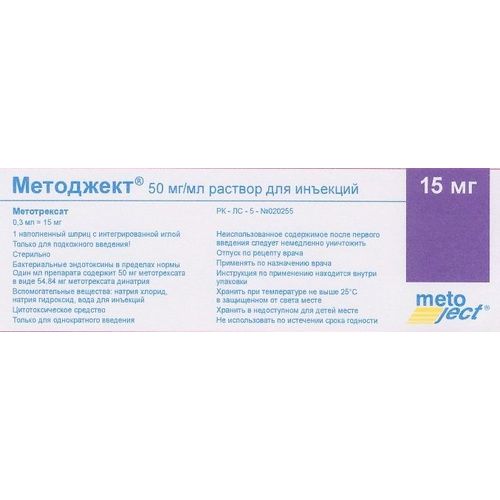
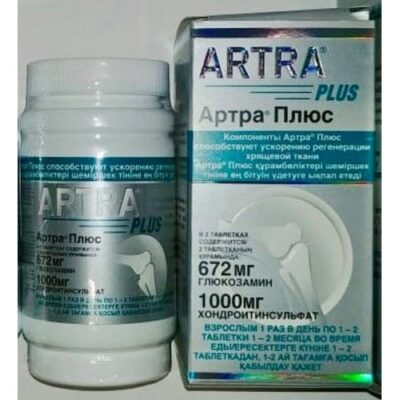
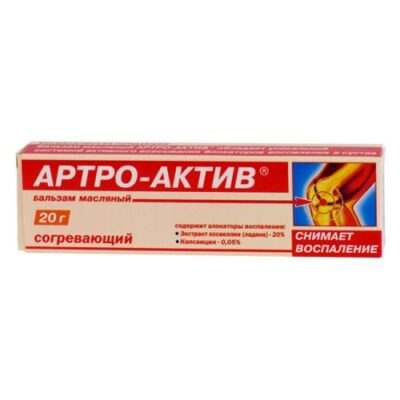

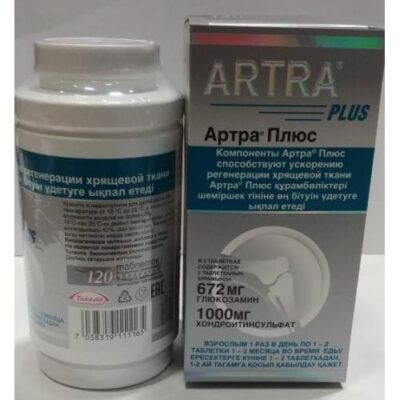
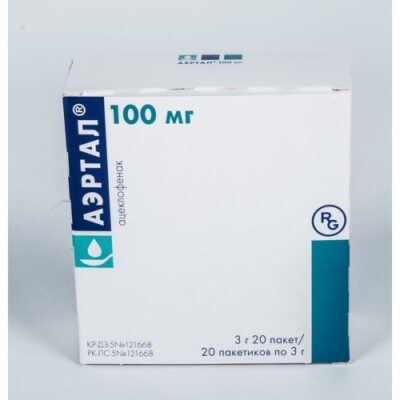
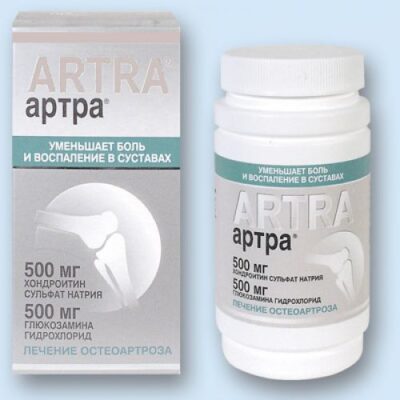
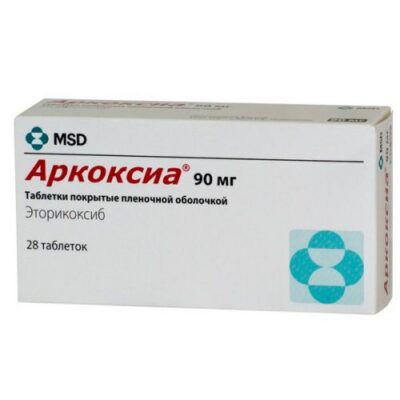
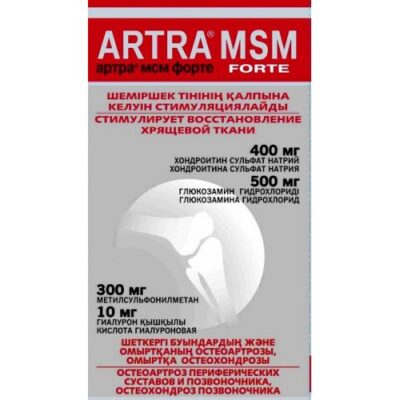
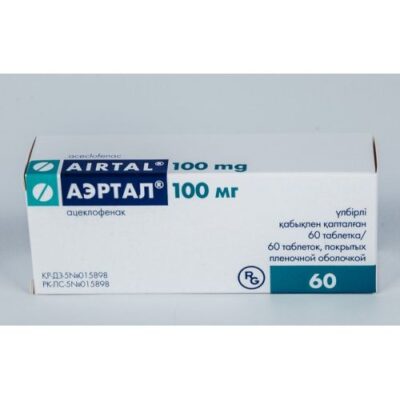
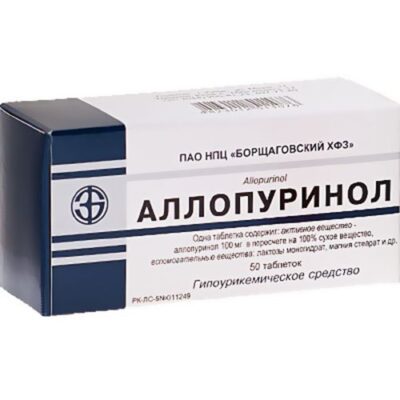






Reviews
There are no reviews yet.